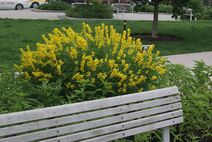Baptisia tinctoria
| Baptisia tinctoria | |
 | |
| Light: | |
| Moisture: | |
| Hardiness: | 5 |
| Soil pH: | 5.6-7.3 |
| Height: | 3' |
| Width: | 2' |
| Blooms: | Mid Summer-Late Summer |
| Native to: | |
| Nitrogen Fixer Nectary | |
| Edible Rating: | |
| Medicinal Rating: | |
| Tea: | Yes |
Baptisia tinctoria (common name: wild indigo)
Propagation: Seed - best sown as soon as it is ripe in a cold frame[1]. Stored seed should be pre-soaked for 24 hours in warm water and then sown in a cold frame in late winter or early spring. Prick out the seedlings into individual pots as soon as they are large enough to handle and plant them out into their permanent positions in the summer or following spring.
Division in spring[2]. Larger divisions can be planted straight into their permanent positions whilst smaller clumps are best potted up and kept in a cold frame until they are growing away well.
Cultivation: Prefers a deep, rich, well-drained neutral to slightly acid soil in full sun[1][3]. Grows freely in a loamy soil.
Plants are shy flowering in British gardens[1][3].
Plants have a very deep root system and dislike root disturbance, they should be left alone once they are established[2][3].
This species has a symbiotic relationship with certain soil bacteria, these bacteria form nodules on the roots and fix atmospheric nitrogen. Some of this nitrogen is utilized by the growing plant but some can also be used by other plants growing nearby[1].
Range: Eastern N. America - Virginia to Florida.
Habitat: Dry soils in open woods and clearings[4][5].
Edibility: Young shoots - cooked. An asparagus substitute[6][7][8][9]. Some caution is advised, see the notes above on toxicity.
Medicinal: Wild indigo was a favourite medicine of the N. American Indians, a decoction of the roots being used as an antiseptic wash for wounds and skin complaints[10][11]. Modern research has shown that this acrid bitter herb stimulates the immune system[12][11] and is particularly effective against bacterial infections[11]. Caution is advised in the internal use of this plant, large or frequent doses are potentially harmful[12].
A tea made from the roots is cholagogue, emetic, febrifuge and purgative[13][4][14][15][12]. The fresh root is also considered to be antiseptic, astringent and laxative[13][4][14][15][12]. The infusion is used in the treatment of upper respiratory infections such as tonsillitis and pharyngitis, and is also valuable in treating infections of the chest, gastro-intestinal tract and skin[16].The plants antimicrobial and immune-stimulant properties combat lymphatic problems, when used with detoxifying herbs such as Arctium lappa it helps to reduce enlarged lymph nodes[16]. Wild indigo is frequently prescribed, along with Echinacea, in the treatment of chronic viral infections or chronic fatigue syndrome[16]. A decoction of the root soothes sore or infected nipples and infected skin conditions[16]. When used as a mouth wash or gargle the decoction treats mouth ulcers, gum infections and sore throats[16].
The fresh root, including the bark, is used to make a homeopathic medicine[17]. This has a limited range of action, but is used especially in the treatment of certain types of flu[17].
Usage: This species is related to the tropical plant Indigo (Indigofera tinctoria) and, like that species, contains a blue dyestuff in the leaves[18]. The dyestuff is only contained in very low concentrations, however, and a very large quantity of leaves would be required to obtain reasonable quantities of indigo[19]. A yellow dye can also be obtained from the plant[20].
If the growing plant is harvested and hung up, it is said to repel flies[10].
Soil: Can grow in light and medium soils.
Drainage: Prefers well drained soil.
In Leaf: Mid Spring-Mid Fall
Seed Ripens: Late Summer-Mid Fall
Flower Type: Hermaphrodite
Known Hazards: The plant is poisonous in large quantities[4][14].
Links
References
- ↑ 1.0 1.1 1.2 1.3 Huxley, Anthony. The New Royal Horticultural Society Dictionary of Gardening. MacMillan Press, 1992.
- ↑ 2.0 2.1 Brickell, Christopher. The RHS Gardener's Encyclopedia of Plants and Flowers. Dorling Kindersley Publishers, 1990.
- ↑ 3.0 3.1 3.2 Thomas, Graham. Perennial Garden Plants. J. M. Dent & Sons, 1990.
- ↑ 4.0 4.1 4.2 4.3 Lust, John. The Herb Book. Bantam Books, 1983.
- ↑ Lyndon, Merritt. Gray's Manual of Botany. American Book Co, 1950.
- ↑ Hedrick, Ulysses. Sturtevant's Edible Plants of the World. Dover Publications, 1972.
- ↑ Tanaka, Tyōzaburō. Tanaka's Cyclopaedia of Edible Plants of the World. Keigaku Publishing, 1976.
- ↑ Yanovsky, Elias. Food Plants of the North American Indians Publication 237. US Department of Agriculture.
- ↑ Kunkel, Günther. Plants for Human Consumption. Koeltz Scientific Books, 1984.
- ↑ 10.0 10.1 Weiner, Michael. Earth Medicine, Earth Food. Ballantine Books, 1980.
- ↑ 11.0 11.1 11.2 Bown, Deni. Royal Horticultural Society Encyclopaedia of Herbs and Their Uses. Dorling Kindersley, 1995.
- ↑ 12.0 12.1 12.2 12.3 Foster, Steven and Billy Tatum. Medicinal Plants of Eastern and Central North America. Houghton Mifflin, 1990.
- ↑ 13.0 13.1 Grieve, Margaret. A Modern Herbal. Penguin, 1984.
- ↑ 14.0 14.1 14.2 Uphof, Johannes. Dictionary of Economic Plants. Weinheim, 1959.
- ↑ 15.0 15.1 Mills, Simon. The Dictionary of Modern Herbalism.
- ↑ 16.0 16.1 16.2 16.3 16.4 Chevallier, Andrew. The Encyclopedia of Medicinal Plants. Dorling Kindersley, 1996.
- ↑ 17.0 17.1 Castro, Miranda. The Complete Homeopathy Handbook. Macmillan, 1990.
- ↑ Chittendon, Fred. RHS Dictionary of Plants. Oxford University Press, 1951.
- ↑ Buchanan, Rita. A Weavers Garden.
- ↑ Usher, George. A Dictionary of Plants Used by Man. Constable, 1974.